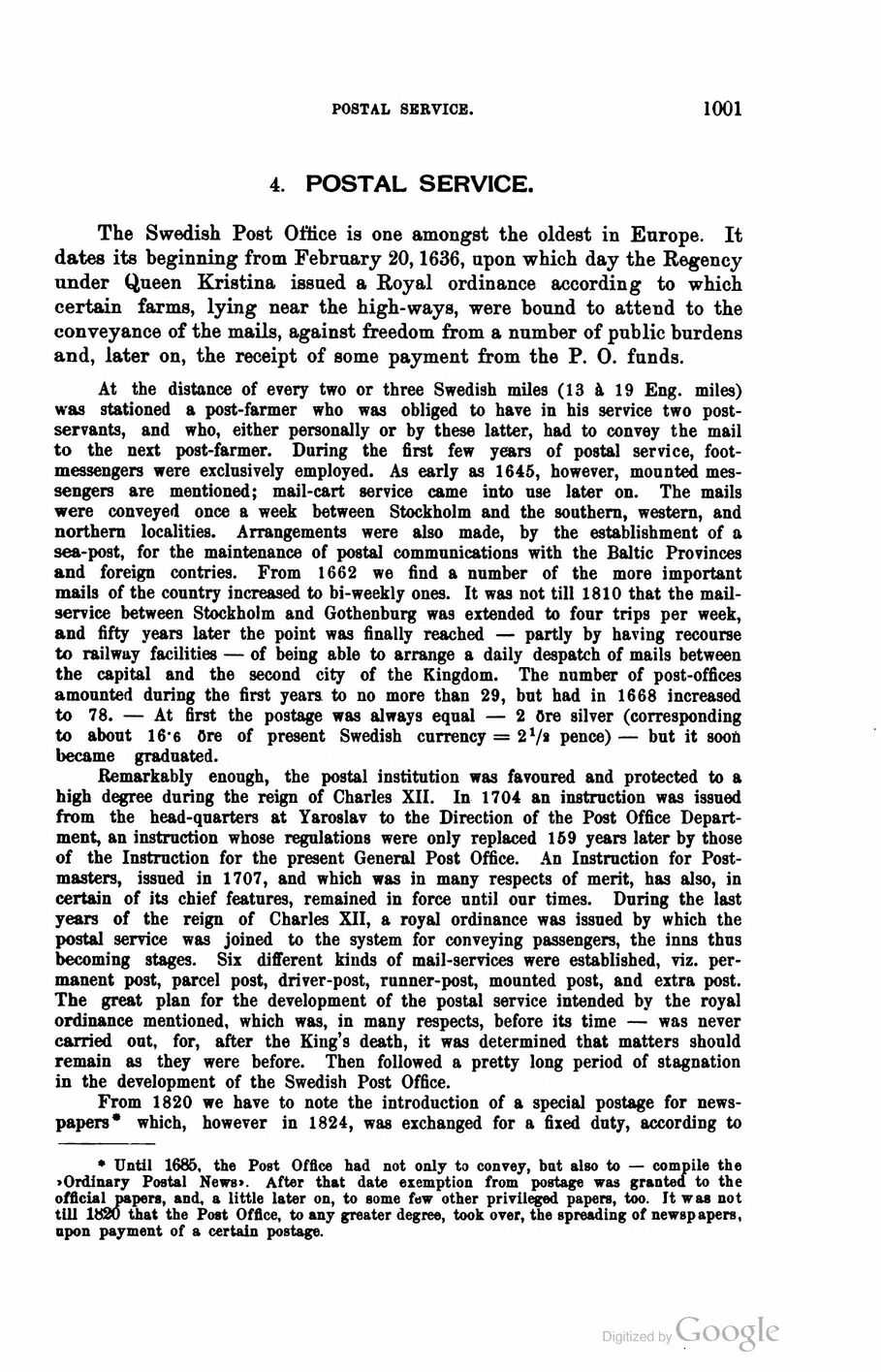
Full resolution (JPEG) - On this page / på denna sida - Second part - XIII. Internal Communications - 4. Postal Service. By R. Lundgren, Actuary at the General Post Office

<< prev. page << föreg. sida << >> nästa sida >> next page >>
Below is the raw OCR text
from the above scanned image.
Do you see an error? Proofread the page now!
Här nedan syns maskintolkade texten från faksimilbilden ovan.
Ser du något fel? Korrekturläs sidan nu!
This page has never been proofread. / Denna sida har aldrig korrekturlästs.
POSTAL 8BKVICE.
1001
4. POSTAL SERVICE.
The Swedish Post Office is one amongst the oldest in Europe. It
dates its beginning from February 20,1636, upon which day the Regency
under Queen Kristina issued a Royal ordinance according to which
certain farms, lying near the high-ways, were bound to attend to the
conveyance of the mails, against freedom from a number of public burdens
and, later on, the receipt of some payment from the P. 0. funds.
At the distance of every two or three Swedish miles (13 à 19 Eng. miles)
was stationed a post-farmer who was obliged to have in his service two
post-servants, and who, either personally or by these latter, had to convey the mail
to the next post-farmer. During the first few years of postal service,
foot-messengers were exclusively employed. As early as 1645, however, mounted
messengers are mentioned; mail-cart service came into use later on. The mails
were conveyed once a week between Stockholm and the southern, western, and
northern localities. Arrangements were also made, by the establishment of a
sea-post, for the maintenance of postal communications with the Baltic Provinces
and foreign contries. From 1662 we find a number of the more important
mails of the country increased to bi-weekly ones. It was not till 1810 that the
mail-service between Stockholm and Gothenburg was extended to four trips per week,
and fifty years later the point was finally reached — partly by having recourse
to railway facilities — of being able to arrange a daily despatch of mails between
the capital and the second city of the Kingdom. The number of post-offices
amounted during the first years to no more than 29, but had in 1668 increased
to 78. — At first the postage was always equal — 2 Ore silver (corresponding
to about 16-6 Ore of present Swedish currency = 21/» pence) — but it soon
became graduated.
Remarkably enough, the postal institution was favoured and protected to a
high degree during the reign of Charles XII. In 1704 an instruction was issued
from the head-quarters at Yaroslav to the Direction of the Post Office
Department, an instruction whose regulations were only replaced 159 years later by those
of the Instruction for the present General Post Office. An Instruction for
Postmasters, issued in 1707, and which was in many respects of merit, has also, in
certain of its chief features, remained in force until our times. During the last
years of the reign of Charles XII, a royal ordinance was issued by which the
postal service was joined to the system for conveying passengers, the inns thus
becoming stages. Six different kinds of mail-services were established, viz.
permanent post, parcel post, driver-post, runner-post, mounted post, and extra post.
The great plan for the development of the postal service intended by the royal
ordinance mentioned, which was, in many respects, before its time — was never
carried out, for, after the King’s death, it was determined that matters should
remain as they were before. Then followed a pretty long period of stagnation
in the development of the Swedish Post Office.
From 1820 we have to note the introduction of a special postage for
newspapers* which, however in 1824, was exchanged for a fixed duty, according to
* Until 1685, the Post Office had not only to convey, but also to — compile the
»Ordinary Postal News». After that date exemption from postage was granted to the
officialpapers, and, a little later on, to some few other privileged papers, too. It was not
till 1820 that the Post Office, to any greater degree, took over, the spreading of newspapers,
upon payment of a certain postage.
<< prev. page << föreg. sida << >> nästa sida >> next page >>